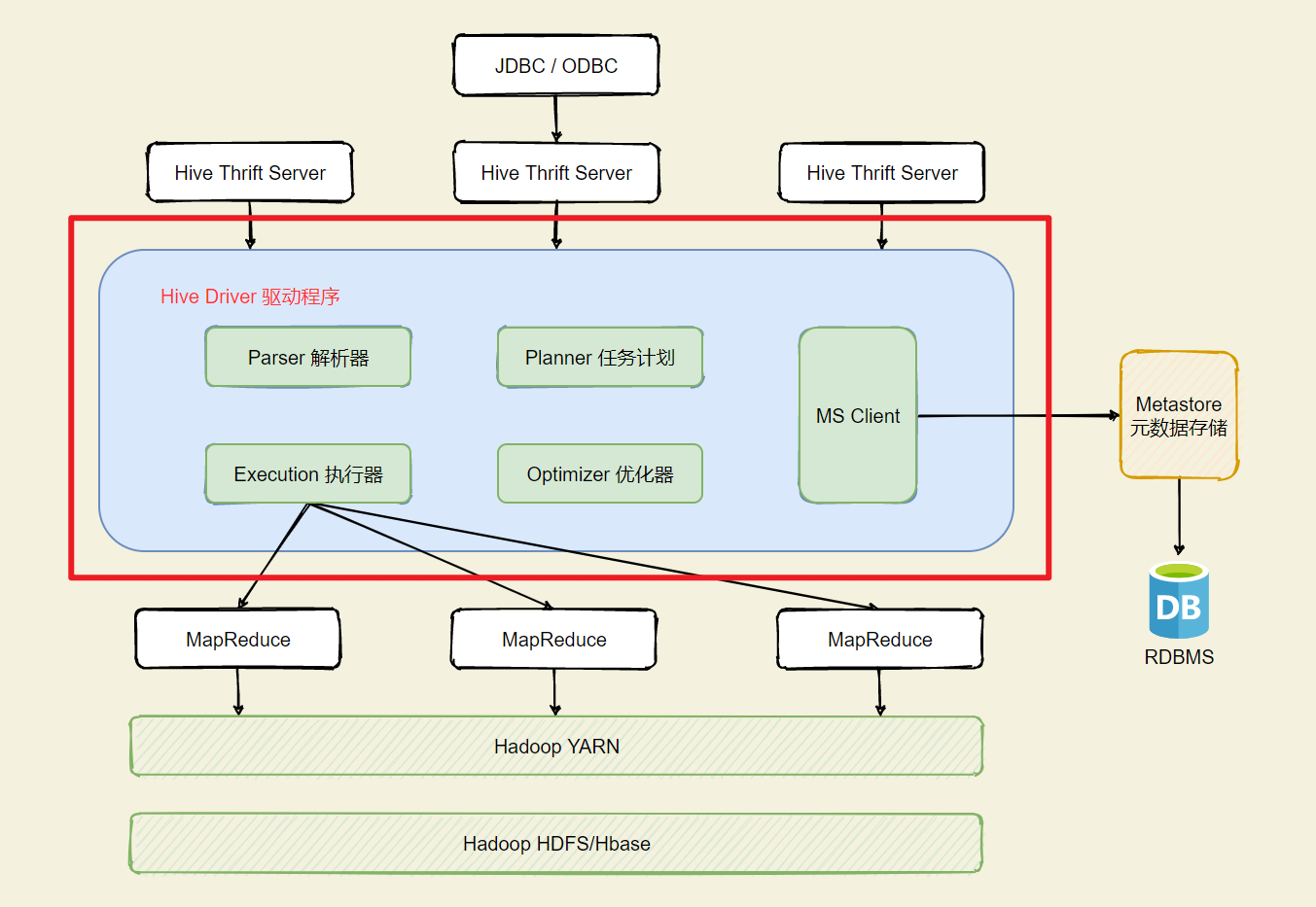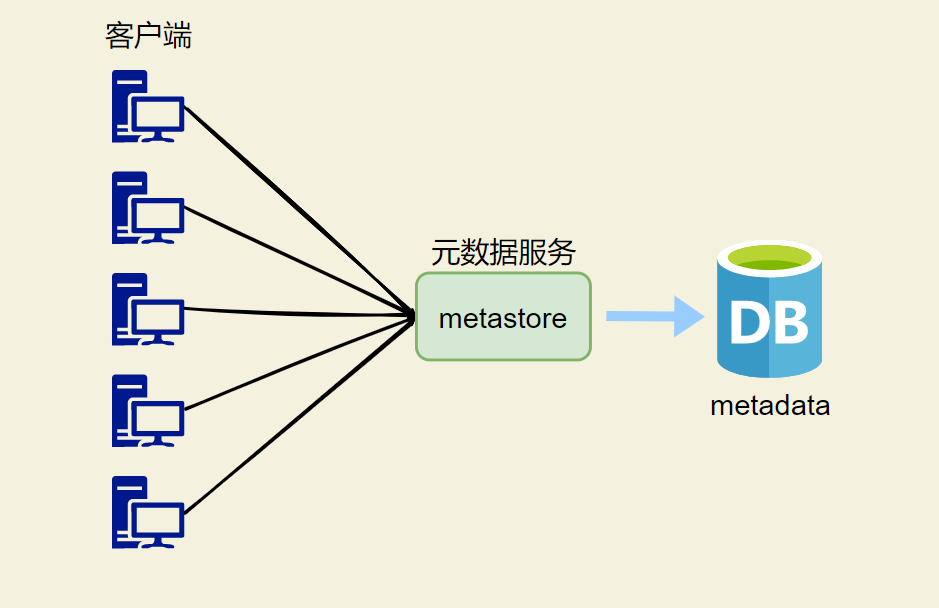数据仓库
为了分析数据而来,分析结果给企业决策提供支撑
数仓概念
- 数据仓库(英语:Data Warehouse,简称数仓、DW),是一个用于存储、分析、报告的数据系统
- 数据仓库的目的是构建面向分析的集成化数据环境,分析结果为企业提供决策支持(Decision Support)
专注分许
- 数据仓库本身并不“生产”任何数据,其数据来源于不同外部系统
- 同时数据仓库自身也不需要“消费”任何的数据,其结果开放给各个外部应用使用
- 这也是为什么叫“仓库”,而不叫“工厂”的原因
OLTP 系统
OLTP系统的核心是面向业务,支持业务,支持事务
可以,但是没有必要
所有的业务操作可以分为读、写两种操作,一般来说读的压力明显大于写的压力
如果在OLTP环境直接开展各种分析,需要考虑:
- 数据分析也是对数据进行读取操作,会让读取压力倍增
- OLTP仅存储数周或数月的数据
- 数据分散在不同系统不同表中,字段类型属性不统一
目的
为了更好的进行各种规模的数据分析,同时也不影响OLTP系统运行
此时需要构建一个集成统一的数据分析平台
目的:面向分析,支持分析,并且和OLTP系统解耦合
构建
- 数仓是一个用于存储、分析、报告的数据系统,目的是构建面向分析的集成化数据环境
- 这种
面向分析、支持分析的系统称之为OLAP(联机分析处理)系统 - 数据仓库是OLAP系统的一种实现
特征
- 面向主题
- 较高层次上数据综合、归类并进行分析利用的抽象
- 抽象层次上对数据进行完整、一致和准确的描述
- 集成性
- 数据通常会分布在多个操作型系统中,彼此分散、独立、异构
- 必然要经过统一与综合,对数据进行抽取、清理、转换和汇总
- 要统一源数据中所有矛盾之处
- 进行数据综合和计算
- 非易失性
- 数据仓库是分析数据的平台,而不是创造数据的平台
- 数据仓库的数据反映的是一段相当长的时间内历史数据的内容
- 数据仓库中一般有
大量的查询操作,但修改和删除操作很少
- 时变性
- 包含各种粒度的历史数据,数据可能与某个特定日期、星期、月份、季度或者年份有关
- 当业务变化后会失去时效性,因此数据仓库的数据需要随着时间更新,以适应决策的需要
- 从这个角度讲,数据仓库建设是一个项目,更是一个过程
开发语言(SQL)
SQL的难点不在语法,知道怎么用就行了
后面在具体情况下,再说说使用什么操作
Hive
- 建立在Hadoop之上的开源数据仓库系统
- 将存储在Hadoop文件中的结构化、半结构化数据文件映射为一张数据库表,基于表提供了一种类似SQL的查询模型
- 称为Hive查询语言(HQL),用于访问和分析存储在Hadoop文件中的大型数据集
- Hive核心是将HQL转换为MapReduce程序,然后将程序提交到Hadoop群集执行
- Hive由Facebook实现并开源
Hive 和 Hadoop
- 从功能来说,数据仓库软件,至少需要具备下述两种能力
- 存储数据的能力
- 分析数据的能力
- Apache Hive作为一款大数据时代的数据仓库软件,当然也具备上述两种能力
- 只不过Hive并不是自己实现了上述两种能力,而是借助Hadoop
- Hive利用HDFS存储数据,利用MapReduce查询分析数据
- 这样突然发现Hive没啥用,不过是套壳Hadoop罢了
- 其实不然,Hive的最大的魅力在于用户专注于编写HQL,Hive帮您转换成为MapReduce程序完成对数据的分析
模拟 Hive
- Hive能将数据文件映射成为一张表,这个映射是指什么?
- 文件和表之间的对应关系
- Hive软件本身到底承担了什么功能职责
- SQL语法解析编译成MapReduce

架构图

组件
用户接口
包括
CLI、JDBC/ODBC、WebGUI
- CLI(command line interface)为shell命令行
- Hive中的Thrift服务器允许外部客户端通过网络与Hive进行交互
- 类似于JDBC或ODBC协议。WebGUI是通过浏览器访问Hive

- 通常是存储在关系数据库如 mysql/derby中
- Hive 中的元数据包括
- 表的名字
- 表的列和分区及其属性
- 表的属性(是否为外部表等)
- 表的数据所在目录等

驱动程序
语法解析器、计划编译器、优化器、执行器
- 完成 HQL 查询语句从词法分析、语法分析、编译、优化以及查询计划的生成
- 生成的查询计划存储在 HDFS 中,并在随后有执行引擎调用执行

执行引擎
- Hive本身并不直接处理数据文件
- 而是通过执行引擎处理
- 当下Hive支持MapReduce、Tez、Spark3种执行引擎

元数据
- 又称中介数据、中继数据,为描述数据的数据(data about data)
- 主要是描述数据属性(property)的信息
- 用来支持如指示存储位置、历史数据、资源查找、文件记录等功能
Hive Metadata即Hive的元数据
- 包含用Hive创建的database、table、表的位置、类型、属性,字段顺序类型等元信息
- 元数据存储在关系型数据库中
- 如hive内置的Derby、或者第三方如MySQL等
元数据服务(Metastore)
- 管理metadata元数据,对外暴露服务地址
- 让各种客户端通过连接metastore服务,由metastore再去连接MySQL数据库来存取元数据
- 有了metastore服务,就可以有多个客户端同时连接
- 而且这些客户端不需要知道MySQL数据库的用户名和密码,只需要连接metastore 服务即可
- 某种程度上也保证了hive元数据的安全

配置metastore
| 内嵌模式 | 本地模式 | 远程模式 | |
|---|---|---|---|
| Metastore单独配置、启动 | 否 | 否 | 是 |
| Metadata存储介质 | Derby | MySQL | MySQL |
metastore服务配置有3种模式:
- 内嵌模式
- 本地模式
- 远程模式
区分3种配置方式的关键是弄清楚两个问题:
- Metastore服务是否需要单独配置、单独启动?
- Metadata是存储在内置的derby中,还是第三方RDBMS,比如MySQL
远程metastore
在生产环境中,建议用远程模式来配置Hive Metastore
在这种情况下,其他依赖hive的软件都可以通过Metastore访问hive
由于还可以完全屏蔽数据库层,因此这也带来了更好的可管理性/安全性
Remote Metastore 远程模式:

安装部署
安装 MySQL
在一台机器上安装MySQL,远程其他机器远程访问即可
卸载mariadb
# 查询本机的 mariadb, 返回什么删除什么
rpm -qa | grep mariadb
# mariadb-libs-5.5.68-1.el7.x86_64
# 删除
rpm -e mariadb-libs-5.5.68-1.el7.x86_64 --nodeps
# 再次查看
rpm -qa|grep mariadb
安装MySQL
# 创建MySQL文件夹
mkdir /hadoop/software/mysql && cd mysql
# 将MySQL安装包发送到此处
# 解压
tar xvf mysql-5.7.29-1.el7.x86_64.rpm-bundle.tar
# 安装依赖-libaio
yum -y install libaio
# 安装MySQL
rpm -ivh mysql-community-common-5.7.29-1.el7.x86_64.rpm mysql-community-libs-5.7.29-1.el7.x86_64.rpm mysql-community-client-5.7.29-1.el7.x86_64.rpm mysql-community-server-5.7.29-1.el7.x86_64.rpm

初始化MySQL
#初始化
mysqld --initialize
#更改所属组
chown mysql:mysql /var/lib/mysql -R
#启动mysql
systemctl start mysqld.service
#查看生成的临时root密码
cat /var/log/mysqld.log
# 下面这句话会提示密码
[Note] A temporary password is generated for root@localhost: sOLjp4jO4n&7
# 汇总命令
mysqld --initialize && chown mysql:mysql /var/lib/mysql -R && systemctl start mysqld.service
cat /var/log/mysqld.log
修改、授权
mysql -u root -p
Enter password: #这里输入在日志中生成的临时密码
# 更新root密码
alter user user() identified by "root";
# 授权
use mysql;
GRANT ALL PRIVILEGES ON *.* TO 'root'@'%' IDENTIFIED BY 'root' WITH GRANT OPTION;
FLUSH PRIVILEGES;
exit;
# mysql的启动、关闭、状态查看
systemctl stop mysqld
systemctl status mysqld
systemctl start mysqld
# 开机自启
systemctl enable mysqld
# 查看是否已经设置自启动成功
systemctl list-unit-files | grep mysqld
# mysqld.service enabled
卸载MySQL
# 关闭mysql服务
systemctl stop mysqld.service
# 查找安装mysql的rpm包
[root@node-211 ~]# rpm -qa | grep -i mysql
mysql-community-libs-5.7.29-1.el7.x86_64
mysql-community-common-5.7.29-1.el7.x86_64
mysql-community-client-5.7.29-1.el7.x86_64
mysql-community-server-5.7.29-1.el7.x86_64
# 卸载
[root@node-211 ~]# yum remove mysql-community-libs-5.7.29-1.el7.x86_64 mysql-community-common-5.7.29-1.el7.x86_64 mysql-community-client-5.7.29-1.el7.x86_64 mysql-community-server-5.7.29-1.el7.x86_64
# 查看是否卸载干净
rpm -qa | grep -i mysql
# 查找mysql相关目录 删除
[root@node1 ~]# find / -name mysql
/var/lib/mysql
/var/lib/mysql/mysql
/usr/share/mysql
[root@node1 ~]# rm -rf /var/lib/mysql
[root@node1 ~]# rm -rf /var/lib/mysql/mysql
[root@node1 ~]# rm -rf /usr/share/mysql
# 删除默认配置 日志
rm -rf /etc/my.cnf
rm -rf /var/log/mysqld.log
安装 Hive
解压安装包
tar zxvf apache-hive-3.1.2-bin.tar.gz
ls
# apache-hive-3.1.2-bin hadoop-3.3.0 jdk1.8.0_241 mysql
版本差异
Hive与Hadoop之间guava版本差异
# 删除hive中的guava包
cd /hadoop/software/apache-hive-3.1.2-bin/
rm lib/guava-19.0.jar -rf
# 从hadoop中复制guava
cp ../hadoop-3.3.0/share/hadoop/common/lib/guava-27.0-jre.jar ./lib/
修改配置文件
hive-env.sh
cd /hadoop/software/apache-hive-3.1.2-bin/conf
mv hive-env.sh.template hive-env.sh
vi hive-env.sh
export HADOOP_HOME=/hadoop/software/hadoop-3.3.0
export HIVE_CONF_DIR=/hadoop/software/apache-hive-3.1.2-bin/conf
export HIVE_AUX_JARS_PATH=/hadoop/software/apache-hive-3.1.2-bin/lib
hive-site.xml
# 新建这个文件
vi hive-site.xml
<configuration>
<!-- 存储元数据mysql相关配置 -->
<property>
<name>javax.jdo.option.ConnectionURL</name>
<value>jdbc:mysql://node-211:3306/hive3?createDatabaseIfNotExist=true&useSSL=false&useUnicode=true&characterEncoding=UTF-8</value>
</property>
<property>
<name>javax.jdo.option.ConnectionDriverName</name>
<value>com.mysql.jdbc.Driver</value>
</property>
<!-- 连接MySQL的 用户名 -->
<property>
<name>javax.jdo.option.ConnectionUserName</name>
<value>root</value>
</property>
<!-- 连接MySQL的 密码 -->
<property>
<name>javax.jdo.option.ConnectionPassword</name>
<value>root</value>
</property>
<!-- H2S运行绑定host -->
<property>
<name>hive.server2.thrift.bind.host</name>
<value>node-211</value>
</property>
<!-- 远程模式部署metastore metastore地址 -->
<property>
<name>hive.metastore.uris</name>
<value>thrift://node-211:9083</value>
</property>
<!-- 关闭元数据存储授权 -->
<property>
<name>hive.metastore.event.db.notification.api.auth</name>
<value>false</value>
</property>
</configuration>
上传jar包
mysql-connector-java-5.1.32.jar
初始化元数据
cd /hadoop/software/apache-hive-3.1.2-bin/
bin/schematool -initSchema -dbType mysql -verbos
# 初始化成功会在mysql中创建74张表
创建hive存储目录
hadoop fs -mkdir /tmp
hadoop fs -mkdir -p /user/hive/warehouse
hadoop fs -chmod g+w /tmp
hadoop fs -chmod g+w /user/hive/warehouse
启动 hive
启动metastore服务
# 前台启动 关闭ctrl+c
/hadoop/software/apache-hive-3.1.2-bin/bin/hive --service metastore
# 前台启动开启debug日志
/hadoop/software/apache-hive-3.1.2-bin/bin/hive --service metastore --hiveconf hive.root.logger=DEBUG,console
# 后台启动 进程挂起 关闭使用jps + kill -9
nohup /hadoop/software/apache-hive-3.1.2-bin/bin/hive --service metastore &
# 日志在当前目录下的nohup.out中
cat nohup.out
# 关闭,jps 查看进程号
jps
kill -9 jps_id

远程模式下beeline通过 Thrift 连接到单独的HiveServer2服务上(官方推荐在生产环境中使用)- HiveServer2支持多客户端的并发和身份认证,旨在为开放API客户端如JDBC、ODBC提供更好的支持
关系
- HiveServer2通过Metastore服务读写元数据
- 所以在远程模式下,启动HiveServer2之前必须先首先启动metastore服务
- 特别注意
- 远程模式下,Beeline客户端只能通过HiveServer2服务访问Hive
- 而bin/hive是通过Metastore服务访问的

# 前台带日志启动hiveserver2
/hadoop/software/apache-hive-3.1.2-bin/bin/hive --service hiveserver2 --hiveconf hive.root.logger=DEBUG,console
# 后台启动hiveserver2
nohup /hadoop/software/apache-hive-3.1.2-bin/bin/hive --service hiveserver2 &
# 注意 启动hiveserver2需要一定的时间
# 不要启动之后立即beeline连接 可能连接不上
测试连接
1、 beeline客户端连接
- 拷贝node-211上的安装包到beeline客户端机器上(node-212)
scp -r /hadoop/software/apache-hive-3.1.2-bin/ root@node-212:/hadoop/software/
- error
Error: Could not open client transport with JDBC Uri: jdbc:hive2://node1:10000: Failed to open new session: java.lang.RuntimeException: org.apache.hadoop.ipc.RemoteException(org.apache.hadoop.security.authorize.AuthorizationException): User: root is not allowed to impersonate root (state=08S01,code=0)
<!--在hadoop的配置文件core-site.xml中添加如下属性:-->
<property>
<name>hadoop.proxyuser.root.hosts</name>
<value>*</value>
</property>
<property>
<name>hadoop.proxyuser.root.groups</name>
<value>*</value>
</property>
Hive 客户端
- bin/hive
# 直接运行这条命令,就启动了hive
/hadoop/software/apache-hive-3.1.2-bin/bin/hive
- bin/beeline
# beeline需要先连接hiveserver2
# 再通过hiveserver2 连接 metastore
# 而且需要手动连接
/hadoop/software/apache-hive-3.1.2-bin/bin/beeline
beeline> ! connect jdbc:hive2://node-211:10000
Connecting to jdbc:hive2://node-211:10000
Enter username for jdbc:hive2://node-211:10000: root
Enter password for jdbc:hive2://node-211:10000: # 这里直接回车就可以了
中文乱码
-- 注意:
-- 下面sql语句是需要在MySQL中执行
-- 修改Hive存储的元数据信息(metadata)
use hive3;
show tables;
alter table hive3.COLUMNS_V2 modify column COMMENT varchar(256) character set utf8;
alter table hive3.TABLE_PARAMS modify column PARAM_VALUE varchar(4000) character set utf8;
alter table hive3.PARTITION_PARAMS modify column PARAM_VALUE varchar(4000) character set utf8 ;
alter table hive3.PARTITION_KEYS modify column PKEY_COMMENT varchar(4000) character set utf8;
alter table hive3.INDEX_PARAMS modify column PARAM_VALUE varchar(4000) character set utf8;
# 需要删除表,重新创建才会生效
Hive SQL
DML
group by 语法限制,group by语法中的字段- 要么是group by分组的字段
- 要么是被聚合函数应用的字段
避免出现一个字段多个值的歧义
- having和where区别
| 执行时间 | 可否使用聚合函数 | |
|---|---|---|
| where | 分组前过滤 | 后面不可以使用聚合函数 |
| having | 分组后过滤 | 后面可以使用聚合函数 |
- 执行顺序:
from > where > group > having > order > select
show databases;
use hadoop;
------------Hive SQL-DML-Load加载数据---------------
-- step1:建表
-- 建表 student_local 用于演示从本地加载数据
create table student_local
(
num int,
name string,
sex string,
age int,
dept string
) row format delimited fields terminated by ',';
-- 建表student_HDFS 用于演示从HDFS加载数据
create table student_HDFS
(
num int,
name string,
sex string,
age int,
dept string
) row format delimited fields terminated by ',';
-- 建议使用beeline客户端 可以显示出加载过程日志信息
-- step2:加载数据
-- 从本地加载数据 数据位于HS2(node1)本地文件系统 本质是hadoop fs -put上传操作
load data local inpath '/root/students.txt' into table hadoop.student_local;
select * from student_local;
-- 从HDFS加载数据 数据位于HDFS文件系统根目录下 本质是hadoop fs -mv 移动操作
-- 先把数据上传到HDFS上 hadoop fs -put students.txt /
load data inpath '/students.txt' into table hadoop.student_hdfs;
select * from student_hdfs;
------------Hive SQL-DML-Insert插入数据-----------------
-- step1:创建一张源表student
drop table if exists student;
create table student
(
num int,
name string,
sex string,
age int,
dept string
) row format delimited fields terminated by ',';
-- step2:加载数据
load data local inpath '/root/students.txt' into table student;
select * from student;
-- step3:创建一张目标表 只有两个字段
create table student_from_insert
(
sno int,
sname string
);
-- 使用insert+select插入数据到新表中
insert into table student_from_insert select num,name from student;
select * from student_from_insert;
------------Hive SQL select查询基础语法------------
-- 创建表t_usa_covid19
drop table if exists t_usa_covid19;
CREATE TABLE t_usa_covid19
(
count_date string,
county string,
state string,
fips int,
cases int,
deaths int
) row format delimited fields terminated by ",";
-- 将数据load加载到t_usa_covid19表对应的路径下
load data local inpath '/root/us-covid19-counties.dat' into table t_usa_covid19;
-- 1、select_expr
-- 查询所有字段或者指定字段
select * from t_usa_covid19;
select county, cases, deaths from t_usa_covid19;
-- 查询常数返回 此时返回的结果和表中字段无关
select 1 from t_usa_covid19;
-- 查询当前数据库
select current_database();
--省去from关键字
-- 2、ALL DISTINCT
-- 返回所有匹配的行
select state from t_usa_covid19;
-- 相当于
select all state from t_usa_covid19;
-- 返回所有匹配的行 去除重复的结果
select distinct state from t_usa_covid19;
-- 多个字段distinct 整体去重
select distinct county, state from t_usa_covid19;
-- 3、WHERE CAUSE
select * from t_usa_covid19 where 1 > 2; -- 1 > 2 返回false
select * from t_usa_covid19 where 1 == 1; -- 1 = 1 返回true
-- 找出来自于California州的疫情数据
select * from t_usa_covid19 where state = 'California';
--where条件中使用函数 找出州名字母长度超过10位的有哪些
select * from t_usa_covid19 where length(state) > 10;
-- 注意:where条件中不能使用聚合函数
-- --报错 SemanticException:Not yet supported place for UDAF 'count'
-- 聚合函数要使用它的前提是结果集已经确定。
-- 而where子句还处于“确定”结果集的过程中,因而不能使用聚合函数。
select state, sum(deaths) from t_usa_covid19 where sum(deaths) > 100 group by state;
--可以使用Having实现
select state, sum(deaths) from t_usa_covid19 group by state having sum(deaths) > 100;
-- 4、聚合操作
-- 统计美国总共有多少个县county
select county as itcast from t_usa_covid19;
-- 学会使用as 给查询返回的结果起个别名
select count(county) as county_cnts from t_usa_covid19;
-- 去重distinct
select count(distinct county) as county_cnts from t_usa_covid19;
-- 统计美国加州有多少个县
select count(county) from t_usa_covid19 where state = "California";
-- 统计德州总死亡病例数
select sum(deaths) from t_usa_covid19 where state = "Texas";
-- 统计出美国最高确诊病例数是哪个县
select max(cases) from t_usa_covid19;
-- 5、GROUP BY
select * from t_usa_covid19;
-- 根据state州进行分组 统计每个州有多少个县county
select count(county) from t_usa_covid19 where count_date = "2021-01-28" group by state;
-- 想看一下统计的结果是属于哪一个州的
select state, count(county) as county_nums from t_usa_covid19 where count_date = "2021-01-28" group by state;
-- 再想看一下每个县的死亡病例数,我们猜想很简单呀 把deaths字段加上返回 真实情况如何呢?
select state, count(county), sum(deaths) from t_usa_covid19 where count_date = "2021-01-28" group by state;
-- 很尴尬 sql报错了org.apache.hadoop.hive.ql.parse.SemanticException:Line 1:27 Expression not in GROUP BY key 'deaths'
-- 为什么会报错??group by的语法限制
-- 结论:出现在GROUP BY中select_expr的字段:要么是GROUP BY分组的字段;要么是被聚合函数应用的字段。
-- deaths不是分组字段 报错
-- state是分组字段 可以直接出现在select_expr中
-- 被聚合函数应用
select state, count(county), sum(deaths) from t_usa_covid19 where count_date = "2021-01-28" group by state;
-- 6、having
-- 统计2021-01-28死亡病例数大于10000的州
select state, sum(deaths) from t_usa_covid19 where count_date = "2021-01-28" and sum(deaths) > 10000 group by state;
-- where语句中不能使用聚合函数 语法报错
-- 先where分组前过滤,再进行group by分组, 分组后每个分组结果集确定 再使用having过滤
select state, sum(deaths) from t_usa_covid19 where count_date = "2021-01-28" group by state having sum(deaths) > 10000;
-- 这样写更好 即在group by的时候聚合函数已经作用得出结果 having直接引用结果过滤 不需要再单独计算一次了
select state, sum(deaths) as cnts from t_usa_covid19 where count_date = "2021-01-28" group by state having cnts > 10000;
-- 7、order by
-- 根据确诊病例数升序排序 查询返回结果
select * from t_usa_covid19;
select * from t_usa_covid19 order by cases;
-- 不写排序规则 默认就是asc升序
select * from t_usa_covid19 order by cases asc;
-- 根据死亡病例数倒序排序 查询返回加州每个县的结果
select * from t_usa_covid19 where state = "California" order by cases desc;
select state,count(county) from t_usa_covid19 where count_date="2021-01-28" order by state;
-- 8、limit
-- 没有限制返回2021.1.28 加州的所有记录
select * from t_usa_covid19 where count_date = "2021-01-28" and state = "California";
-- 返回结果集的前5条
select * from t_usa_covid19 where count_date="2021-01-28" and state="California" limit 5;
-- 返回结果集从第1行开始 共3行
select * from t_usa_covid19 where count_date = "2021-01-28" and state = "California" limit 2,3;
-- 注意 第一个参数偏移量是从0开始的
-- 执行顺序
select state, sum(deaths) as cnts from t_usa_covid19 where count_date = "2021-01-28" group by state having cnts > 10000 limit 2;
------------Hive Join SQL 语法------------
-- Join语法练习 建表
drop table if exists employee_address;
drop table if exists employee_connection;
drop table if exists employee;
-- table1: 员工表
CREATE TABLE employee(id int,name string,deg string,salary int,dept string) row format delimited fields terminated by ',';
-- table2:员工家庭住址信息表
CREATE TABLE employee_address(id int,hno string,street string,city string) row format delimited fields terminated by ',';
-- table3:员工联系方式信息表
CREATE TABLE employee_connection(id int,phno string,email string) row format delimited fields terminated by ',';
-- 加载数据到表中
load data local inpath '/root/test-file/employee.txt' into table employee;
load data local inpath '/root/test-file/employee_address.txt' into table employee_address;
load data local inpath '/root/test-file/employee_connection.txt' into table employee_connection;
-- 验证数据
show tables;
select * from employee;
select * from employee_address;
select * from employee_connection;
-- 1、inner join
select e.id, e.name, e_a.city, e_a.street from employee e inner join employee_address e_a on e.id = e_a.id;
-- 等价于 inner join=join
select e.id, e.name, e_a.city, e_a.street from employee e join employee_address e_a on e.id = e_a.id;
-- 等价于 隐式连接表示法
select e.id, e.name, e_a.city, e_a.street from employee e, employee_address e_a where e.id = e_a.id;
-- 2、left join
select e.id, e.name, e_conn.phno, e_conn.email from employee e left join employee_connection e_conn on e.id = e_conn.id;
-- 等价于 left outer join
select e.id, e.name, e_conn.phno, e_conn.email from employee e left outer join employee_connection e_conn on e.id = e_conn.id;
-----------------Hive 常用的内置函数----------------------
show functions;
describe function extended count;
------------String Functions 字符串函数------------
-- 查看字符串长度
select length("spark");
-- 字符串反转
select reverse("spark");
-- 字符串拼接
select concat("angela", "baby");
-- 带分隔符字符串连接函数:concat_ws(separator, [string | array(string)]+)
select concat_ws('.', 'www', array('spark', 'cn'));
-- 字符串截取函数:
-- substr(str, pos[, len]) 或者 substring(str, pos[, len])
select substr("hadoop-spark", -5);
-- pos是从1开始的索引,如果为负数则倒着数
select substr("hadoop-spark", 2, 2);
-- 分割字符串函数: split(str, regex)
-- split针对字符串数据进行切割 返回是数组array 可以通过数组的下标取内部的元素 注意下标从0开始的
select split('apache hive', ' ');
select split('apache hive', ' ')[0];
select split('apache hive', ' ')[1];
----------- Date Functions 日期函数 -----------------
-- 获取当前日期: current_date
select current_date();
-- 获取当前UNIX时间戳函数: unix_timestamp
select unix_timestamp();
-- 日期转UNIX时间戳函数: unix_timestamp
select unix_timestamp("2011-12-07 13:01:03");
-- 指定格式日期转UNIX时间戳函数: unix_timestamp
select unix_timestamp('20111207 13:01:03', 'yyyyMMdd HH:mm:ss');
-- UNIX时间戳转日期函数: from_unixtime
select from_unixtime(1618238391);
select from_unixtime(0, 'yyyy-MM-dd HH:mm:ss');
-- 日期比较函数: datediff 日期格式要求'yyyy-MM-dd HH:mm:ss' or 'yyyy-MM-dd'
select datediff('2022-12-01', '2022-01-01');
-- 日期增加函数: date_add
select date_add('2012-02-28', 10);
-- 日期减少函数: date_sub
select date_sub('2012-01-1', 10);
----Mathematical Functions 数学函数-------------
-- 取整函数: round 返回double类型的整数值部分 (遵循四舍五入)
select round(3.1415926);
-- 指定精度取整函数: round(double a, int d) 返回指定精度d的double类型
select round(3.1415926, 4);
-- 取随机数函数: rand 每次执行都不一样 返回一个0到1范围内的随机数
select rand();
-- 指定种子取随机数函数: rand(int seed) 得到一个稳定的随机数序列
select rand(5);
-----Conditional Functions 条件函数------------------
-- 使用之前课程创建好的student表数据
select * from student limit 3;
-- if条件判断: if(boolean testCondition, T valueTrue, T valueFalseOrNull)
select if(1 = 2, 100, 200);
select if(sex = '男', 'M', 'W') from student limit 3;
-- 空值转换函数: nvl(T value, T default_value)
select nvl("allen", "spark");
select nvl(null, "itcast");
-- 条件转换函数: CASE a WHEN b THEN c [WHEN d THEN e]* [ELSE f] END
select case 100 when 50 then 'tom' when 100 then 'mary' else 'tim' end;
select case sex when '男' then 'male' else 'female' end from student limit 3;
Join
根据两个或多个表中的列之间的关系,从这些表中共同组合查询数据
- table_reference:是join查询中使用的表名
- table_factor:与table_reference相同,是联接查询中使用的表名
- join_condition:join查询关联的条件,如果在两个以上的表上需要连接,则使用AND关键字
inner join(内连接)
两张表的
交集只有进行连接的
两个表中都存在与连接条件相匹配的数据才会被留下来

left join(左连接)
左外连接,两张表的
并集join时以左表的全部数据为准,右边与之关联,左表数据全部返回,右表:
- 关联上的显示返回
- 关联不上的显示null返回

函数
show functions:查看当下可用的所有函数describe function extended funcname:查看函数的使用方式
内置函数
- 字符串函数
- length:字符串长度函数
- reverse:字符串反转函数
- concat:字符串连接函数
- concat_ws:带分隔符字符串连接函数
- substr、substring:字符串截取函数
select length("itcast");
select reverse("itcast");
select concat("angela","baby");
-- 带分隔符字符串连接函数:concat_ws(separator, [string | array(string)]+)
select concat_ws('.', 'www', array('itcast', 'cn'));
-- 字符串截取函数:substr(str, pos[, len]) 或者 substring(str, pos[, len])
select substr("angelababy",-2); --pos是从1开始的索引,如果为负数则倒着数
select substr("angelababy",2,2);
-- 分割字符串函数: split(str, regex)
select split('apache hive', ' ');
- 日期类型函数
-- 获取当前日期: current_date
select current_date();
-- 获取当前UNIX时间戳函数: unix_timestamp
select unix_timestamp();
-- 日期转UNIX时间戳函数: unix_timestamp
select unix_timestamp("2011-12-07 13:01:03");
-- 指定格式日期转UNIX时间戳函数: unix_timestamp
select unix_timestamp('20111207 13:01:03','yyyyMMdd HH:mm:ss');
-- UNIX时间戳转日期函数: from_unixtime
select from_unixtime(1618238391);
select from_unixtime(0, 'yyyy-MM-dd HH:mm:ss');
-- 日期比较函数: datediff 日期格式要求'yyyy-MM-dd HH:mm:ss' or 'yyyy-MM-dd'
select datediff('2012-12-08','2012-05-09');
-- 日期增加函数: date_add
select date_add('2012-02-28',10);
-- 日期减少函数: date_sub
select date_sub('2012-01-1',10);
- 数值类型函数
-- 取整函数: round 返回double类型的整数值部分 (遵循四舍五入)
select round(3.1415926);
-- 指定精度取整函数: round(double a, int d) 返回指定精度d的double类型
select round(3.1415926,4);
-- 取随机数函数: rand 每次执行都不一样 返回一个0到1范围内的随机数
select rand();
-- 指定种子取随机数函数: rand(int seed) 得到一个稳定的随机数序列
select rand(3);
- 条件函数
-- 使用之前课程创建好的student表数据
select * from student limit 3;
-- if条件判断: if(boolean testCondition, T valueTrue, T valueFalseOrNull)
select if(1=2,100,200);
select if(sex ='男','M','W') from student limit 3;
-- 空值转换函数: nvl(T value, T default_value)
select nvl("allen","itcast");
select nvl(null,"itcast");
-- 条件转换函数: CASE a WHEN b THEN c [WHEN d THEN e]* [ELSE f] END
select case 100 when 50 then 'tom' when 100 then 'mary' else 'tim' end;
select case sex when '男' then 'male' else 'female' end from student limit 3;
用户定义函数
根据输入输出的行数区分
- UDF(User-Defined-Function):普通函数,一进一出
- UDAF(User-Defined Aggregation Function):聚合函数,多进一出
- UDTF(User-Defined Table-Generating Functions):表生成函数,一进多出
案例
show databases;
--------------1、建库-------------------
-- 如果数据库已存在就删除
drop database if exists db_msg cascade;
-- 创建数据库
create database db_msg;
-- 切换数据库
use db_msg;
--------------2、建表-------------------
-- 如果表已存在就删除
drop table if exists db_msg.tb_msg_source;
-- 建表
create table db_msg.tb_msg_source
(
msg_time string comment "消息发送时间",
sender_name string comment "发送人昵称",
sender_account string comment "发送人账号",
sender_sex string comment "发送人性别",
sender_ip string comment "发送人ip地址",
sender_os string comment "发送人操作系统",
sender_phonetype string comment "发送人手机型号",
sender_network string comment "发送人网络类型",
sender_gps string comment "发送人的GPS定位",
receiver_name string comment "接收人昵称",
receiver_ip string comment "接收人IP",
receiver_account string comment "接收人账号",
receiver_os string comment "接收人操作系统",
receiver_phonetype string comment "接收人手机型号",
receiver_network string comment "接收人网络类型",
receiver_gps string comment "接收人的GPS定位",
receiver_sex string comment "接收人性别",
msg_type string comment "消息类型",
distance string comment "双方距离",
message string comment "消息内容"
) row format delimited fields terminated by '\t';
--------------3、加载数据-------------------
-- 上传数据文件到node1服务器本地文件系统(HS2服务所在机器)
-- shell: mkdir -p /root/test-file/project
-- 加载数据到表中
load data local inpath '/root/test-file/project/data1.tsv' into table db_msg.tb_msg_source;
load data local inpath '/root/test-file/project/data2.tsv' into table db_msg.tb_msg_source;
-- 查询表 验证数据文件是否映射成功
select * from tb_msg_source limit 10;
-- 统计行数
select count(*) as cnt from tb_msg_source;
--------------4、ETL数据清洗-------------------
-- 问题1:当前数据中,有一些数据的字段为空,不是合法数据
select msg_time, sender_name, sender_gps from db_msg.tb_msg_source where length(sender_gps) = 0 limit 10;
-- 问题2:需求中,需要统计每天、每个小时的消息量,但是数据中没有天和小时字段,只有整体时间字段,不好处理
select msg_time from db_msg.tb_msg_source limit 10;
-- 问题3:需求中,需要对经度和维度构建地区的可视化地图,但是数据中GPS经纬度为一个字段,不好处理
select sender_gps from db_msg.tb_msg_source limit 10;
-- ETL实现
-- 如果表已存在就删除
drop table if exists db_msg.tb_msg_etl;
-- 将Select语句的结果保存到新表中
create table db_msg.tb_msg_etl as
select *,
substr(msg_time, 0, 10) as dayinfo, --获取天
substr(msg_time, 12, 2) as hourinfo, --获取小时
split(sender_gps, ",")[0] as sender_lng, --提取经度
split(sender_gps, ",")[1] as sender_lat --提取纬度
from db_msg.tb_msg_source
-- 过滤字段为空的数据
where length(sender_gps) > 0;
-- 验证ETL结果
select msg_time, dayinfo, hourinfo, sender_gps, sender_lng, sender_lat from db_msg.tb_msg_etl limit 10;
--------------5、需求指标统计分析-------------------
-- 需求:统计今日总消息量
create table if not exists tb_rs_total_msg_cnt comment "今日消息总量" as
select dayinfo, count(*) as total_msg_cnt
from db_msg.tb_msg_etl
group by dayinfo;
select * from tb_rs_total_msg_cnt;
-- 需求:统计今日每小时消息量、发送和接收用户数
create table if not exists tb_rs_hour_msg_cnt comment "每小时消息量趋势" as
select dayinfo,
hourinfo,
count(*) as total_msg_cnt,
count(distinct sender_account) as sender_usr_cnt,
count(distinct receiver_account) as receiver_usr_cnt
from db_msg.tb_msg_etl
group by dayinfo, hourinfo;
select * from tb_rs_hour_msg_cnt;
-- 需求:统计今日各地区发送消息数据量
create table if not exists tb_rs_loc_cnt
comment "今日各地区发送消息总量"
as
select dayinfo,
sender_gps,
cast(sender_lng as double) as longitude,
cast(sender_lat as double) as latitude,
count(*) as total_msg_cnt
from db_msg.tb_msg_etl
group by dayinfo, sender_gps, sender_lng, sender_lat;
select * from tb_rs_loc_cnt;
--需求:统计今日发送消息和接收消息的用户数
create table if not exists tb_rs_usr_cnt
comment "今日发送消息人数、接受消息人数"
as
select dayinfo,
count(distinct sender_account) as sender_usr_cnt,
count(distinct receiver_account) as receiver_usr_cnt
from db_msg.tb_msg_etl
group by dayinfo;
select * from tb_rs_usr_cnt;
--需求:统计今日发送消息最多的Top10用户
create table if not exists tb_rs_susr_top10
comment "发送消息条数最多的Top10用户"
as
select dayinfo,
sender_name as username,
count(*) as sender_msg_cnt
from db_msg.tb_msg_etl
group by dayinfo, sender_name
order by sender_msg_cnt desc
limit 10;
select * from tb_rs_susr_top10;
-- 需求:统计今日接收消息最多的Top10用户
create table if not exists tb_rs_rusr_top10
comment "接受消息条数最多的Top10用户"
as
select dayinfo,
receiver_name as username,
count(*) as receiver_msg_cnt
from db_msg.tb_msg_etl
group by dayinfo, receiver_name
order by receiver_msg_cnt desc
limit 10;
select * from tb_rs_rusr_top10;
-- 需求:统计发送人的手机型号分布情况
create table if not exists tb_rs_sender_phone
comment "发送人的手机型号分布"
as
select dayinfo,
sender_phonetype,
count(distinct sender_account) as cnt
from tb_msg_etl
group by dayinfo, sender_phonetype;
select * from tb_rs_sender_phone;
-- 需求:统计发送人的设备操作系统分布情况
create table if not exists tb_rs_sender_os
comment "发送人的OS分布"
as
select dayinfo,
sender_os,
count(distinct sender_account) as cnt
from tb_msg_etl
group by dayinfo, sender_os;
select * from tb_rs_sender_os;





评论区